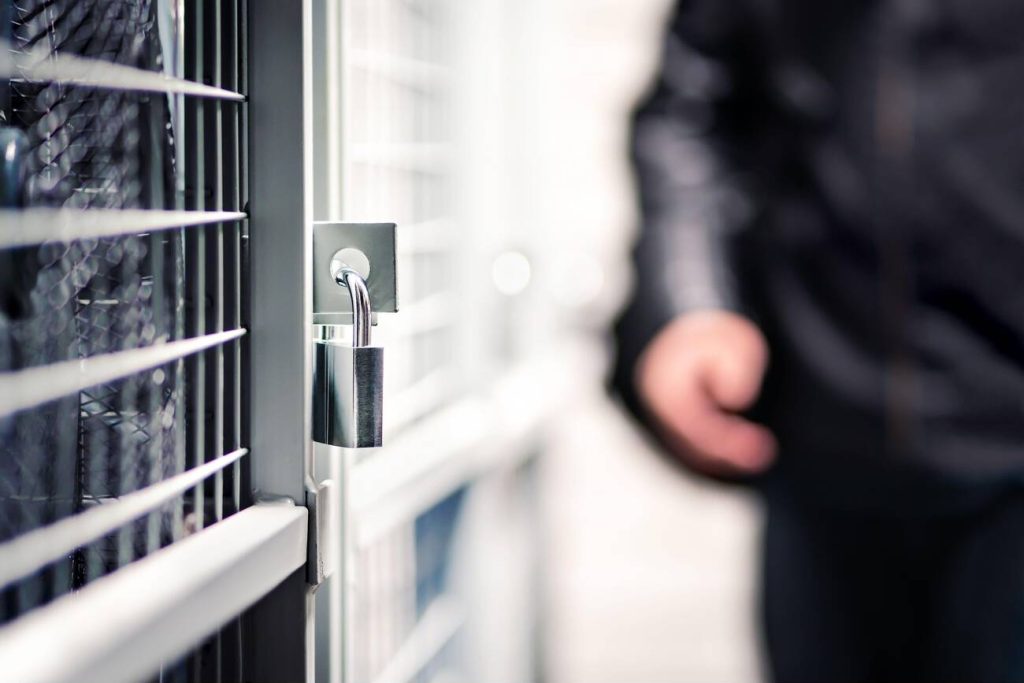Imagine this scenario: you’re at home, getting ready to turn in for the night. As you lay in bed, you suddenly realize that you forgot to lock your garage door. Panic sets in as you imagine all the valuable items stored inside. But fear not! In this article, we will guide you through the process of locking your garage door effectively. From different types of locks to additional security measures, we’ve got you covered. So, let’s dive in and secure that garage door!
Types of Garage Door Locks
Most modern garage doors have built-in locks, such as spring-loaded tab latches or T-handle locks. When comparing locking mechanisms for your garage door, it’s important to choose the right lock that provides the level of security you need. Consider the pros and cons of electronic locks, which offer convenience and enhanced security through unique access codes and smartphone integration. To ensure proper installation of a garage door lock, follow a comprehensive installation guide. Additionally, here are some tips for garage door security: reinforce the door with a solid-core or metal material, install security cameras or motion sensor lights, and consider an alarm system for added deterrence. By implementing these measures, you can enhance the security of your garage door.
How to Use Garage Door Locks
To engage the lock on your garage door, close it completely and insert the key into the T-handle lock, turning it clockwise. This simple process ensures that your garage door is securely locked, preventing unauthorized access. However, there are common garage door lock problems that you may encounter, such as keys getting stuck or locks becoming jammed. If you need to install a new garage door lock, it is recommended to consult a professional to ensure proper installation. To maintain your garage door lock, regularly clean and lubricate it to prevent rust and ensure smooth operation. If you’re looking for alternatives to traditional garage door locks, consider installing electronic locks or adding extra security measures such as security cameras or motion sensor lights. If you experience any issues with your garage door lock, troubleshoot by checking for obstructions or contacting a professional for assistance.
Assessing Garage Door and Security Needs
Evaluate the type of material your garage door is made of to determine the appropriate lock for your security needs. Some common materials include wood, metal, and fiberglass. Once you have identified the material, you can begin evaluating security measures and choosing the right lock. Consider the following factors:
- Securing garage door windows: If your garage door has windows, it is important to ensure they are properly secured to prevent unauthorized access.
- Integrating smart home technology: Explore options for integrating your garage door lock with your smart home system for added convenience and security.
- Garage door lock maintenance: Regularly inspect and maintain your garage door lock to ensure it is functioning properly and providing the level of security you need.
Additional Locking Mechanisms
Electronic locks, such as keypad locks, offer convenience and enhanced security for securing your garage. When it comes to additional locking mechanisms for your garage door, there are several options to consider. T-handle locks are centrally located on the door and require a key for operation, providing a basic level of security. Slide bolt locks, on the other hand, are installed on the inside of the door and offer enhanced security by engaging a metal rod into the track. Another option is deadbolt locks, which provide a higher level of security and can be used in conjunction with existing locks. Electronic locks, like keypad locks, eliminate the need for physical keys and can be integrated with smart lock technology for remote access control. These additional locking mechanisms can greatly enhance your garage door security and provide peace of mind.
Additional Security Measures
Consider installing security cameras, motion sensor lights, or an alarm system to enhance the overall security of your garage. These additional security measures can greatly deter potential intruders and provide you with peace of mind. Garage door security cameras allow you to monitor any suspicious activity and provide evidence in case of a break-in. Motion sensor lights illuminate the area around your garage, making it less appealing for burglars to approach. Alarm system installation can alert you and authorities if someone attempts to enter your garage unlawfully. Furthermore, reinforcing your garage door with additional locks and electronic keypad locks can significantly enhance its security. By implementing these measures, you can greatly reduce the risk of theft or break-ins and protect your valuable belongings.
Garage Door Locking Mechanisms
To enhance the security of your garage, explore different types of locks available for your garage door. Consider installing a garage door lock to provide an additional layer of protection. There are various options to choose from, including keyless entry systems and smart lock options. Garage door lock installation is relatively simple and can be done by following the manufacturer’s instructions. Once installed, regular garage door lock maintenance is essential to ensure proper functioning. If you encounter any issues with your garage door lock, troubleshooting steps are available to help you resolve the problem. By investing in a reliable garage door lock and staying proactive with maintenance, you can enhance the security of your garage and protect your belongings.
Extra Security Options for Garage Doors
Installing a slide bolt lock on the inside of the garage door provides enhanced security and is operated manually. This extra security option, along with other measures, can help protect your garage and belongings from potential intruders. Consider these options to further secure your garage door:
- Automatic slide locks: These locks can sync with certain garage door openers, providing an additional layer of security.
- Keyless entry systems: Opt for a keyless entry system that allows you to set a unique access code, eliminating the need for physical keys.
- Garage door defenders: These separate locking mechanisms are bolted to the ground, providing effective external locking for your garage door.
External Locking Options for Garage Doors
Choose the external locking option that best suits your needs and preferences to enhance the security of your garage. When it comes to external locks for your garage door, there are different options to consider. To help you make an informed decision, let’s compare the pros and cons of these locking mechanisms:
| Locking Mechanism | Pros | Cons |
|---|---|---|
| Sliding bar locks with L-handles or T-handles | – Simple installation – Effective external locking | – Requires manual operation – Can be easily bypassed |
| Garage door defenders (stop bars) | – Provides strong external locking – Difficult to tamper with | – Requires separate installation – May obstruct vehicle parking |
| Deadbolt locks | – High level of security – Can be used in combination with existing locks | – Requires a key or code – Additional installation required |
| Electronic locks | – Convenient keyless entry – Smartphone integration and remote access control | – Requires batteries or electrical wiring – Potential for technical issues |
Securing the Emergency Release Lever
Now that you’ve learned about external locking options for garage doors, let’s focus on securing the emergency release lever. It’s important to note some common mistakes and safety considerations when it comes to this crucial component of your garage door security.
- Blocking the emergency release lever with zip ties or padlocks is a common mistake, but it can create a safety hazard in emergencies.
- It’s crucial to ensure that the emergency release lever remains accessible for safety purposes.
- Alternative solutions like Garage Door Armor can provide a recommended option for securing the emergency release lever. This product blocks outside access to the lever while allowing emergency release functionality.
Last Resort Option: Locking the Track
In a last resort situation, you can secure the track by inserting a padlock into the slots or attaching a C-clamp. This method, although effective, should be considered as a temporary solution due to the potential risks and drawbacks. It is important to explore other security options before resorting to locking the track.
To enhance garage security, you can also consider other measures such as installing a garage door lock shield. This shield, made of a wood cleat and a scrap of plywood, can make it nearly impossible for thieves to grab the release cord. Additionally, you can enhance security by installing monitoring solutions, such as a garage door monitor, to receive signals and check the status of your garage door.
Other general security tips include installing an automatic door closer, taking your garage door opener with you, locking the entry door that leads into the house if you have an attached garage, and adding bright lighting, especially motion detector lighting, to deter burglars. Remember to keep your garage secure to protect your belongings and ensure your peace of mind.
Preventing Unauthorized Access to the Garage Door
To prevent unauthorized access to the garage door, it’s important to secure the release cord and consider using a garage door lock shield. This shield, made of a wood cleat and scrap plywood, makes it nearly impossible for someone to grab the release cord. In addition to the lock shield, there are other measures you can take to enhance the security of your garage. Installing a garage door monitor allows you to easily see if the door is open or closed, even if the keypad is not working. Adding an automatic door closer ensures that the door is always closed, whether you’re home or not. And to prevent thieves from easily accessing your garage, it’s recommended to use a keychain remote instead of leaving the remote in your car. By implementing these security measures, you can have peace of mind knowing that your garage is well-protected.
Monitoring the Status of the Garage Door
Adding a garage door monitor allows you to easily receive a signal and see whether your garage door is open or closed. This can provide peace of mind and help you keep track of the status of your garage door, even when you’re not at home. A garage door monitor typically consists of sensors and a monitor that are battery-operated, requiring no wiring. You can place the sensors on your garage door and the monitor inside your home. When the garage door is opened or closed, the sensors will send a signal to the monitor, indicating the status of the door. This is particularly useful if your garage door keypad is not working or if you want an extra layer of security for your garage.
| Garage Door Monitor |
|---|
| Easy to install |
| Battery-operated |
| Provides real-time status of garage door |
| Can be used as a standalone system or integrated into a full home security system |
| Helps prevent accidental leaving of garage door open |
In addition to a garage door monitor, there are other measures you can take to enhance the overall security of your garage. Using a keychain remote for your garage door opener can prevent thieves from easily accessing your garage by stealing the remote from your car. Installing an automatic door closer ensures that the door is closed whether you’re home or not, providing an extra layer of security. Consider beefing up the service door with a deadbolt and heavy-duty strike plate, and make sure to lock the entry door that leads into your house if you have an attached garage. Finally, adding bright lighting, especially motion detector lighting, can make burglars nervous and potentially deter them.





